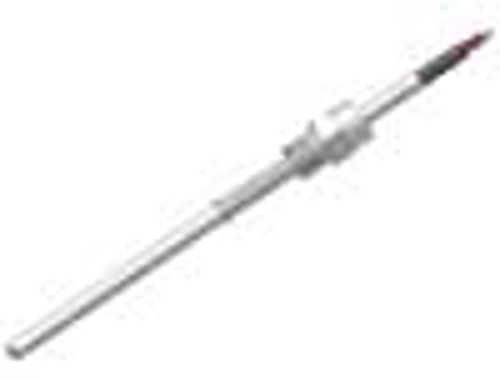
Low temperature resistance sensors spring loaded
Low temperature resistance sensors spring loaded

MN1690 - Temperature Sensor Spring loaded
Key features
- Sensor temperature range : -50 - 150 °C
- Sensor element : Pt100
- Connection : 2, 3 or 4 wire
- Material sensor pipe : AISI304
MN1804 - Temperature Sensor Spring loaded
Key features
- Sensor temperature range : -50 - 150 °C
- Sensor element : Pt100
- Connection : 2, 3 or 4 wire
- Material sensor pipe : AISI304
MN1846 - Temperature Sensor Spring loaded with connection box
Identical with MN1847 except for the sensor tip which is conic with a 118° angle.
Key features
- Sensor temperature range : -50 - 200 °C
- Sensor element : Pt100 or Pt1000
- Connection : 2, 2x2 or 3 wire
- Material sensor pipe : AISI304
- Material connection box : Thermoplastic polyester
- Protection : IP55
MN1847 - Temperature Sensor Spring loaded with connection box
Identical with MN1846 except for the sensor tip which is flat.
Key features
- Sensor temperature range : -50 - 130 °C
- Sensor element : Pt100 or Pt1000
- Connection : 2, 2x2 or 3 wire
- Material sensor pipe : AISI304
- Material connection box : Thermoplastic polyester
- Protection : IP55
MN2120 - Temperature Sensor Spring loaded
Identical with MN2296 except for the sensor tip which is flat.
Key features
- Sensor temperature range : -50 - 200 °C
- Max. temp. sensor tip : 200 °C
- Max. temp. sensor cable : 150 °C
- Sensor element : Pt100 or Pt1000
- Connection : 2 or 4 wire
- Material sensor tip : Brass, flat sensor tip
- Protection : IP56
- Weight : 130 g (MN2120SU15)
MN2296 - Temperature Sensor Spring loaded
Identical with MN2120 except for the sensor tip which is conic with a 118° angle.
Key features
- Sensor temperature range : -50 - 200 °C
- Max. temp. sensor tip : 200 °C
- Max. temp. sensor cable : 150 °C
- Sensor element : Pt100 or Pt1000
- Connection : 2 or 4 wire
- Material sensor tip : Brass 118° sensor tip angle
- Protection : IP56
- Weight : 130 g (MN2296SU15)
MN2952 - Temperature Sensor Spring loaded
Key features
- Sensor temperature range : -50 - 150 °C
- Sensor element : Pt100 or Pt1000
- Connection : 2, 3 or 4 wire
- Material sensor pipe : AISI304
- Material sensor tip : Brass
- Protection : IP56
MN3166 - Temperature Sensor Spring loaded with cable plug
Key features
- Sensor temperature range : -50 - 200 °C
- Max. temp. sensor cable : 155 °C
- Sensor element : Pt100 or Pt1000
- Connection : 2 or 3 wire
- Material sensor pipe : AISI304
- Protection : IP56
MN3192 - Temperature Sensor Spring loaded with cable plug
Key features
- Sensor temperature range : -50 - 200 °C
- Max. temp. sensor cable : 155 °C
- Sensor element : Pt100 or Pt1000
- Connection : 2 or 3 wire
- Material sensor pipe : AISI304
- Protection : IP56
MN3226 - Temperature Sensor Spring loaded with cable plug
Key features
- Sensor temperature range : -50 - 200 °C
- Max. temp. sensor cable : 155 °C
- Sensor element : Pt100 or Pt1000
- Connection : 2 or 3 wire
- Material sensor pipe : AISI304
- Protection : IP56
MN3306 - Temperature Sensor Spring loaded with plug
Key features
- Sensor temperature range : -50 - 200 °C
- Max. temp. plug connector: 125 °C
- Sensor element : Pt100 or Pt1000
- Connection : 2 or 3 wire
- Material sensor pipe : AISI304
- Material sensor plug : Glass Reinforced PA
- Protection : IP65
MN3612 - Temperature Sensor Spring loaded
Key features
- Sensor temperature range: -50 - 200 °C
- Max. temp. sensor : 200 °C
- Max. temp. cable : 150 °C
- Sensor element : Pt100 or Pt1000
- Connection : 2, 2x2 or 4 wire
- Material sensor pipe : AISI304
- Material sensor tip : Brass
- Protection : IP56
Lifecycle support for your vessel
-
24/7 Technical support
Our 24/7 technical support team is there to help at any time, day or night, wherever your vessel is.
Our 24/7 technical support team is there to help at any time, day or night, wherever your vessel is.
-
Conversions, retrofit and refit
Upgrading and enhancing your vessel’s performance.
We understand the importance of having the right parts, available in the right place, at the right time.
-
Training
Maximise crew efficiency and reduce downtime with expert training.
Ensure that your crew is properly and thoroughly trained. This will reduce operational risk, downtime and maximise return on asset investment.